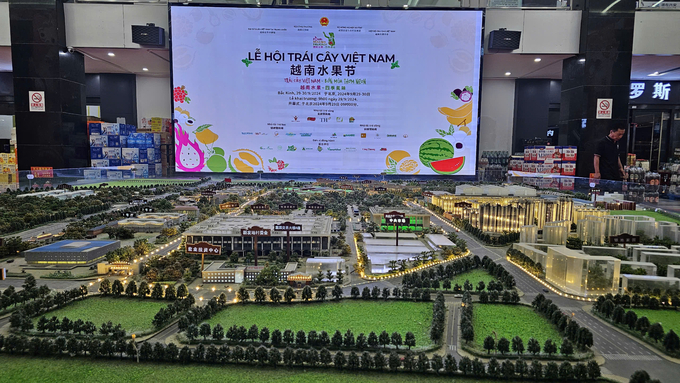April 19, 2025 | 09:17 GMT +7
April 19, 2025 | 09:17 GMT +7
Hotline: 0913.378.918
April 19, 2025 | 09:17 GMT +7
Hotline: 0913.378.918

Mr. Nguyen Quang Hieu, Deputy Director of the Plant Protection Department (MARD), spoke at the Vietnam - China Fruit Trade and Supply Chain Connection Forum on the afternoon of September 29. Photo: Thanh Thuy.
For the first time, the Vietnam Fruit Festival is being held in Beijing (China). In your opinion, what is the significance of this event?
This event holds great significance in promoting the brand and image of Vietnam's fruits in the Chinese market. The festival is an excellent opportunity to introduce Vietnam's high-quality fruit products to Chinese consumers and importers. It also highlights the growing trade relationship between the two countries, especially in the agricultural sector. Hosting the festival in Beijing, the political and economic center of China, will attract widespread attention and open new opportunities for Vietnam's fruit exports.
What is your assessment of the potential of Vietnamese fruits in the Chinese market? What are our strengths, and what weaknesses do we need to address?
Vietnamese fruits have great potential in the Chinese market. Our strength lies in the quality and distinctive taste of tropical fruits, grown under Vietnam’s unique climate and soil conditions. Many fruits like durian, mango, dragon fruit, lychee, longan and bananas have long been favored by Chinese consumers. However, we need to address weaknesses in inconsistent quality and unstable supply to meet the demands of large importers and distributors in China. We also need to promote formal trade exports to ensure sustainable growth and enhance export value.
What is the potential for importing Vietnamese fruits in the Chinese market? Could you tell us the average export value to this market in recent years, and what is the projection for this year?
In the first eight months of 2024, fruit and vegetable exports to China reached 3 billion USD, nearly matching the total export value to this market for all of 2023.

From left: Mr. Le Thanh Hoa - Deputy Director of the Department of Quality, Processing and Market Development; Mr. Nguyen Quang Hieu - Deputy Director of the Plant Protection Department; Mr. Tran Van Cao - Deputy Editor-in-Chief of Vietnam Agriculture Newspaper, visiting a booth at the Vietnam Fruit Festival on the morning of September 30. Photo: Vo Viet.
It is forecasted that fruit and vegetable exports to China will reach between 4.5 and 5 billion USD for the entire year of 2024. As for durian alone, it is estimated to have surpassed the 2.5 billion USD mark by the end of September 2024 and could exceed 3 billion USD by the end of the year.
Looking toward the future, with the current growth trend and increasing demand in the Chinese market, industry experts predict that Vietnam's fruit and vegetable exports have the potential to reach the 10 billion USD mark.
This growth is supported by the expansion of the list of fruits allowed for formal export to China, as well as the development of processed products like frozen and dried durian.
As the specialized agency responsible for technical negotiations to facilitate market access, we consistently view this as an important task. We regularly plan meetings with the General Administration of Customs of China to promote this agenda, contributing to creating new momentum for the fresh fruit export sector.
Leaders of the MARD have repeatedly warned about Vietnamese enterprises violating technical criteria when exporting agricultural products in general, and fruits in particular, to a market of 1.4 billion people. In your opinion, what immediate actions should we take to maintain a healthy and stable export environment in line with the directives of MARD?
To achieve sustainable development in this market, the top priority is to create and deliver the true value of Vietnamese fruits to Chinese consumers. Product quality, distinctive flavor, and food safety are the core values that we need to focus on developing and maintaining. When Chinese consumers recognize these values, they will become loyal customers, establishing a solid foundation for the long-term growth of Vietnam's fruit industry.
To maintain a healthy and stable export environment, we need to concentrate on several key points:
Close collaboration among farmers, businesses, and government regulatory agencies to ensure that every stage of the production chain meets the highest quality standards.
Training and guidance for businesses on the technical standards required by the Chinese market.
Promote official exports to help farmers feel secure in their production, stabilize the market and enhance the value and reputation of Vietnamese fruits in the international market.
Develop a national strategy for branding that focuses on the unique characteristics of Vietnamese fruits, such as "Four seasons delicacy".
Strengthen cooperation with Chinese authorities to promptly address emerging issues. Establish a quick and effective information exchange mechanism between both parties.

The "Vietnam Fruits - Four seasons delicacy" festival was held for the first time in Beijing, China. Photo: Vo Viet.
In addition, it is important to enhance research and development of new plant varieties to meet the diverse demands of the Chinese market. Build a sustainable supply chain from farmers to exporting businesses, ensuring balanced benefits for all participants. Apply technology in production, preservation, and transportation to improve product quality and minimize post-harvest losses. Strengthen the role of industry associations in connecting, sharing information, and supporting businesses. Establish a transparent traceability system to enhance consumer confidence in Vietnamese fruits.
At the first Vietnam Fruit Festival in China, were there any negotiations between the two countries regarding additional Vietnamese fruits entering the Chinese market? Conversely, does China have any plans to export fruits to Vietnam?
Within the framework of this festival, although no formal negotiations between specialized agencies were arranged, the organization of discussions and trade exchanges between businesses from both countries provided a great opportunity to exchange views on the demand and potential for expanding the list of fruits eligible for formal export to China. This feedback will serve as a basis for government agencies to develop negotiation roadmaps and allocate appropriate resources for this task.
Thank you very much!
At the Trade and Supply Chain Connection Forum for Vietnam - China Fruit Import and Export (part of the first Vietnam Fruit Festival in China, held from September 29 - 30 in Beijing), a business cooperation signing ceremony took place between various Vietnamese and Chinese units and enterprises to promote the export of agricultural and seafood products.
Specifically, four agreements were signed: between Ameii Vietnam Joint Stock Company and Beijing Tan Hop Tac Development Company; between the Vietnam Fruit and Vegetable Association and the China Fruit Association; between Vina T&T Group Import-Export Company and Beijing Van Dien Luong Pham Science and Technology Development Co., Ltd.; and between Vina T&T Group Import-Export Company and Asia Trading Co., Ltd.
Translated by Phuong Linh
/2025/04/18/0614-0-nongnghiep-120604.jpg)
(VAN) Cashew nuts are not only a nutritious food but also a golden raw material in both cuisine and export, contributing to elevating Vietnamese agricultural products onto the global stage.

(VAN) Orders from wood processing businesses in Bac Kan Province for export to the U.S. have been cancelled or suspended, even all orders cancelled in some cases.

(VAN) Vietnam is regarded as one of the gateways to enter the Halal market in the Asia-Pacific region, which has the world’s largest Muslim population.

(VAN) With an annual production scale of around 5 million tons, Vietnam has enough potential to transform rice bran into a key export commodity if combined with deep processing.

(VAN) As the world’s largest consumer of bird’s nest products, China is gradually becoming a 'golden' market for Vietnamese bird’s nests.

(VAN) Deputy Minister Phung Duc Tien has directed the fishery sector to diversify its farming objectives during the conference reviewing Q1 performance and outlining tasks for April and Q2/2025.

(VAN) Consumption and production falls in almost every market as industry fears a ‘generational’ change in drinking habits.